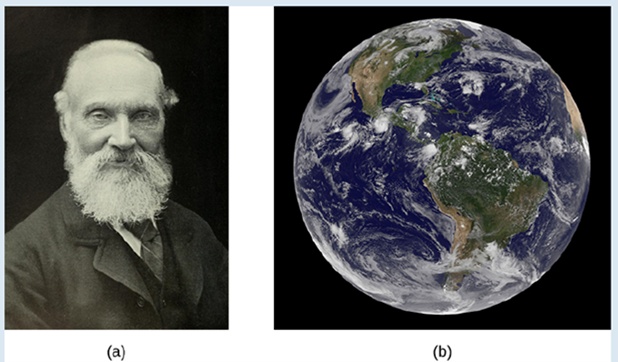
Concept explainers
Lord Kelvin and the Age of Earth
 Figure 4.25 (a) William Thomson (Lord Kelvin). 1824-1907, was a British physicist and electrical engineer. (b) Kelvin used the heat diffusion equation to estimate the age of Earth (credit: modification of work by NASA).
Figure 4.25 (a) William Thomson (Lord Kelvin). 1824-1907, was a British physicist and electrical engineer. (b) Kelvin used the heat diffusion equation to estimate the age of Earth (credit: modification of work by NASA).
During the late 1800s, the scientists of the new field of geology were coming to the conclusion the Earth must be “millions and millions” of years old. At about the same time. Charles Darwin had published his treatise on evolution.
Darwin’s view was that evolution needed many millions of years to take place, and he made a bold claim that the Weald chalk fields, where important fossils were found, were the result of 300 million years of erosion.
At that time, eminent physicist William Thomson (lord Kelvin) used an important partial differential equation, known as the heat diffusion equation, to estimate the age of Earth by determining how long it would take Earth to cool from molten rock to what we had at tha time. His conclusion was a range of 20 to 4(X) million years, but most likely about 5() million years. For many decades, the proclamations of this irrefutable icon of science did not sit well with geologists or with Darwin.
tJR ead Kelvin’s paper (http:Iiwww.openstaxcollege.orgIlI2O KelEarthAge) on estimating the age of the Earth.
Kelvin made reasonable assumptions based on what was known in his time, but he also made several assumptions that turned out to be wrong. One incorrect assumption was that Earth is solid and that the cooling was therefore via conduction only, hence justifying the use of the diffusion equation. But the most serious error was a forgivable one—omission of the fact that Earth contains radioactive elements that continually supply heat beneath Earth’s mantle. The discoveiy of radioactivity came near the end of Kelvin’s life and he acknowledged that his calculation would have to be modified.
Kelvin used the simple one-dimensional model applied only to Earth’s outer shell, and derived the age from gsaphs and the roughly known temperature gs-adietn near Earth’s surface. Let’s take a look at a more appropriate version of the diffusion equation in radial coordinates, which has the form
(4.23)
Here, T(r.t) is temperature as a function of r (measured from the center of Earth) and time i. K is the heat conductivity—for molten rock, in this case. ibe standard method of solving such a partial differential equation is by separation of variables, where we express the solution as the product of functions containing each variable separately. In this case, we would write the temperature as
Want to see the full answer?
Check out a sample textbook solution
Chapter 4 Solutions
Calculus Volume 3
Additional Math Textbook Solutions
Thinking Mathematically (6th Edition)
Basic Business Statistics, Student Value Edition
Elementary Statistics: Picturing the World (7th Edition)
A Problem Solving Approach To Mathematics For Elementary School Teachers (13th Edition)
Calculus: Early Transcendentals (2nd Edition)
- Consider the following training data, shown below before centering. XY 1 0 1 1 1 1 1 1 00 1 1 1 0 0 1 1 1 0 1 1 This data set will be analysed after centering all columns (not scaling). In what follows, the centered data columns are referred to as X and Y. Using these centered columns, we have the following quantities: XTX = 24/11 = 2.1818; XTY = 13/11 = and YTY = 24/11 = 2.1818. Ridge regression Q1 For 2 = R AR = 1.1818 0.56, compute and write in the provided space the ridge estimate ẞ (0.56). Use decimal numbers, not fractions. Q2 Using the ridge estimate ẞ (0.56) you just computed, determine the percentage of shrinkage achieved with respect to the squared L2 norm. That is, compute the shrinkage using || (0.56)||||||with the OLS estimate. In the provided space, write the shrinkage as percentage between 0 and 100 with decimal values. Lasso AR Q3 The following are several expressions for the lasso estimate: (2) = 0.5833 * (1 - 0.84622); L L (a) = 0.5833 * (1 -0.78572); (A) = 0.5417 *…arrow_forward5:38 Video Message instructor Submit Question ||| Darrow_forwardCalculate the 95% confidence intervals for the proportion of children surviving, and the proportion of non-crew adult passengers surviving. We want to use the given data to make inferences about the general population of all large boat crashes, so the data set should be treated as a random sample for this purpose. Part 2 The 95% confidence interval for survival rate amongst non-crew adults runs from enter your response here% to enter your response here%. (Round to one decimal place as needed. Use ascending order.) Part 3 The 95% confidence interval for survival rate amongst children runs from enter your response here% to enter your response here%. (Round to one decimal place as needed. Use ascending order.) Part 4 Test the alternative hypothesis that the proportion of children surviving does not equal 35%, and next, test the alternative hypothesis that the proportion of non-crew adult passengers surviving does not equal 35%. Again, the data set should…arrow_forward
- 1. Given X' = X 3 e2t (a) Verify that X₁(t) = (e) and X2(t) = (et) - are solutions to the given system. (b) Verify that X₁(t) and X2(t) form a fundamental set on the interval (-∞, ∞). (c) Write the general solution to the given system. (d) Find the solution that satisfies the initial condition X(0) = ( 2 ).arrow_forwardProve that a relation X defined on a set A that is reflexive, symmetric and antisymmetric is an equivalence relation and determine the equivalence classes.arrow_forward8:38 *** TEMU TEMU -3 -2 7 B 2 1 & 5G. 61% 1 2 -1 Based on the graph above, determine the amplitude, period, midline, and equation of the function. Use f(x) as the output. Amplitude: 2 Period: 2 Midline: 2 ☑ syntax error: this is not an equation. Function: f(x) = −2 cos(πx + 2.5π) +2× Question Help: Worked Example 1 ☑ Message instructor Submit Question ||| <arrow_forward
- Let X be the relation defined on the power set of the set integers P(Z) by AXB whenever A U B is a finite set of integers. Prove whether or not X is reflexive, symmetric, antisymmetirc or transitivearrow_forward8:39 *** TEMU 5G 60% A ferris wheel is 28 meters in diameter and boarded from a platform that is 2 meters above the ground. The six o'clock position on the ferris wheel is level with the loading platform. The wheel completes 1 full revolution in 4 minutes. The function h = f(t) gives your height in meters above the ground t minutes after the wheel begins to turn. What is the amplitude? 14 meters What is the equation of the Midline? y = 16 What is the period? 4 meters minutes The equation that models the height of the ferris wheel after t minutes is: f(t): = ƒ (3) = ·−14(0) + 16 syntax error: you gave an equation, not an expression. syntax error. Check your variables - you might be using an incorrect one. How high are you off of the ground after 3 minutes? Round your answe the nearest meter. ||| <arrow_forwardcan you solve this question step by step pleasearrow_forward
- S cosx dx sin -3/ (x) Xarrow_forwardUsing the toddler data table in Question 1, describe the toddlers in the sample with joint probabilities only. (300) B(K)-00+300 501 30 smot dbabib (oor de leng 001-009:(00s) 200, yoogie Fox (D) ed to diman edarrow_forwardRight-Handed Left-Handed 24 Gender Males 4 Females 2 12arrow_forward
- Algebra & Trigonometry with Analytic GeometryAlgebraISBN:9781133382119Author:SwokowskiPublisher:Cengage
 Linear Algebra: A Modern IntroductionAlgebraISBN:9781285463247Author:David PoolePublisher:Cengage Learning
Linear Algebra: A Modern IntroductionAlgebraISBN:9781285463247Author:David PoolePublisher:Cengage Learning Trigonometry (MindTap Course List)TrigonometryISBN:9781337278461Author:Ron LarsonPublisher:Cengage Learning
Trigonometry (MindTap Course List)TrigonometryISBN:9781337278461Author:Ron LarsonPublisher:Cengage Learning


